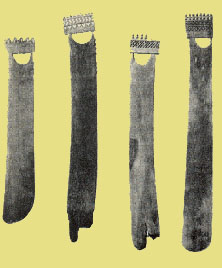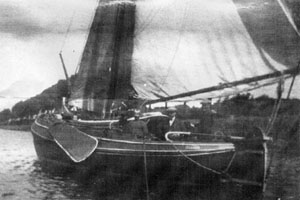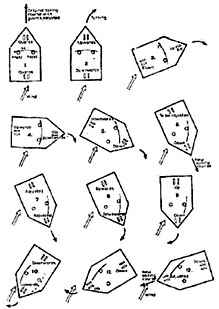 |
|
|
|
WHEN THOR HEYERDAHL WAS DELIGHTED TO BE WRONG
The Case of the Guara or Centerboard
(From Fall 2003 21st Century)
by Rick Sanders
|
|
There is a certain amount of irony in the fact that Thor Heyerdahl, who was not a sailor, proved that some watercraft used by man a very long time ago, were actually more seaworthy than the ones that brought Europeans to America. When the Conquistadores came with their highly unseaworthy ships, they found extremely seaworthy rafts off the Andean coast. These rafts could, for example, land unharmed through the surf, and could carry Indian merchants and their whole extended families, along with 20 tons or more of cargo on board. The Spaniards recorded that the Incas remembered times when large organized flotillas of rafts would set out on direct exploring expeditions to very remote islands. But established academics, especially in the 20th Century, are mostly convinced “isolationists” (a kind of hysteria which asserts that technologies are invented separately around the world, without their diffusion by travelling men). Thus, the accepted view is either to deny that these rafts existed, or to say that if they did exist, they could have been used for short voyages only, because gossip had it that dry balsa gets waterlogged quickly and sinks. And since the gossip fits with the ideology that man is like a little monkey which does not wander very far away from its mother, the gossip got a lot of mileage.
Nevertheless, such rafts did exist, although their most brilliant aspect, the function of the guaras, or centerboards, was not understood until much later by the Europeans who saw them used on the rafts. For centerboards were unknown in Europe, and were, in fact, not adopted (and even then, just as a single centerboard) until the 1870s. (The author’s grandfather, seen in the photo, who fished the Scheldt in Zeeland, in the early 1900s, used lee boards, as did everyone else at the time.)
Explorer Thor Heyerdahl did not know how to use the guaras, although he knew from sketches that they existed, and so he put them on his raft—without knowing their true function. As for the professors who said the rafts could not work, or did not exist, they were not the right ones to ask for the function of the guaras or centerboards.
|
|
 These are miniature guaras, found in prehistoric gravesites. They clearly have a handle, to pull them up or down, but they are totally unsuited to use as a paddle or an oar. These are miniature guaras, found in prehistoric gravesites. They clearly have a handle, to pull them up or down, but they are totally unsuited to use as a paddle or an oar.
|
|
What Is a Guara?
Guaras are made of extremely hard wood, have a knife edge at the front, are 4 to 7 feet in length, and 5 to 10 inches wide. Professional historians could not figure them out, so they said these must be some kind of spade! Other academics opined that they were some kind of paddle!
How ridiculous can you get? Look at this object (in the illustration). There is a handle at the top, which obviously can be used only to raise it an lower it, not for paddling, nor as a rudder or steering oar.
Thor Heyerdahl was more equipped than the academics for discovering the answer to this, but he had no sailing experience when he went on the Kon-tiki expedition. True to his faith in historical truth, he had provided the raft with guaras, but there was no one to tell him how to use them, when to raise them, how far to insert them, what the ratio should be of the ones down in the bow, up in the stern, or some combination of the two.
So the Kon-tiki did not really sail; it drifted—aided by its sail. In fact, two people in a dinghy were almost lost when they could not catch up with the Kon-tiki, and the other crew members were unable to turn the raft around and sail against the wind: “We in the dinghy had to row for our lives out in the open sea in an attempt to regain the unmanageable raft, which could not stop and wait and could not possibly turn around and come back. Even when the boys on board the Kon-tiki got the sail down, the wind got such a grip on the bamboo cabin that the raft drifted away to westward as fast as we could splash after her in the dancing rubber dinghy with its tiny toy oars. There was only one thought in the head of every man—we must not be separated. Those were horrible minutes we spent out on the sea before we got hold of the runaway raft and crawled on board to the others, home again” (Thor Heyerdahl, Kon-tiki, pp. 170-171).
This relentless direction of the Kon-tiki with the wind, led to one of Heyerdahl’s major, early, and wrong conclusions: that only one-way communication was possible between South America and the Pacific islands—that is, by following the wind and the currents, which went from east to west. Later, Heyerdahl triumphantly proved himself wrong.
|
|
 The author’s grandfather still used leeboards. He is seen here, fishing in the Scheldt in Zeeland in the 1920s and 1930s. The author’s grandfather still used leeboards. He is seen here, fishing in the Scheldt in Zeeland in the 1920s and 1930s.
|
|
Finding the Secret—By Experiment!
At some point after the Kon-tiki voyage, Heyerdahl and his friends ran into some intriguing historical material pointing towards the true use of the guara.
The Dutch admiral Spilbergen, in his early drawing of a balsa raft at Payta, Peru, published in 1619, illustrates two cloaked Indians standing by the sails, issuing orders to three others who squat on the raft’s deck, each holding the upper section of his own guara, which is thrust down vertically in the cracks between the logs. The raft has no steering-oar or rudder. Spilbergen says that the sailing raft had been at sea fishing for two months (that is twice as long as Columbus took to reach the new world, and his men nearly threw him overboard because they thought they had been gone too long!), and now returned to Payta harbor with sufficient fish to supply all the ships of Spilbergen’s fleet.
But more than 130 years had to pass before two Spanish naval officers, Juan and Ulloa, discovered the mystery of the guara: “It sails, tacks and works as well in contrary winds as ships with a keel, and makes very little leeway. This advantage it derives from another method of steering than by a rudder, namely, by some boards three or four yards in length, and half a yard in breadth, called guaras, which are placed vertically both at the head and stern between the main beams, and by thrusting some of these deep in the water, and raising others, they bear away, luff up, tack, lay to, and perform all the other motions of a regular ship.
|
|
 Note that these Peruvian rafts could carry as much, or more, cargo as European ships, and were in certain ways much more seaworthy. Note that these Peruvian rafts could carry as much, or more, cargo as European ships, and were in certain ways much more seaworthy.
Source: Thor Heyerdahl, Sea Routes to Polynesia, (London, George Allen and Unwin)
|
|
“An invention hitherto unknown to the most intelligent nations of Europe, a guara being let down in the fore-part of a vessel must make her luff up, and by taking it out she will bear away or fall off. Likewise, on a guara’s being let down at the stern, she will bear away, and by taking out of the water, the balsa will luff, or keep nearer to the wind. Such is the method used by the Indians in steering the balsas, and sometimes they use five or six guaras, to prevent the balsa from making leeway. The method of steering by these guaras is so easy and simple, that when once the balsa is put in her proper course, one only is made use of, raising and lowering it as occasions require, and thus the balsa is always kept in her intended direction” (Kon-tiki, pp. 117-118).
Heyerdahl reports that more on Peruvian guara navigation was published by Humboldt in 1810 and Stevenson in 1825. The latter had seen balsa rafts in Peru, which, merely by means of guara, were “beating up against the wind and current” for hundreds of miles with 25 or 30 tons of cargo (Kon-tiki, p. 118).
Finally, an experimental reconstruction of the ancient sailing techniques was put together. In 1953, with the help of Emilio Estrada, Thor Heyerdahl was able to make practical tests with a regular size balsa raft, and rediscovered the secret of how the Incas could sail their rafts into the wind.
|
|
- f you study these diagrams, keeping in mind the force of the wind, and the resultant force on the sail, you will see the brilliance of the solution of having centerboards that can be raised and lowered toward the stern and the bow of the ship. f you study these diagrams, keeping in mind the force of the wind, and the resultant force on the sail, you will see the brilliance of the solution of having centerboards that can be raised and lowered toward the stern and the bow of the ship.
In an ordinary boat, with one centerboard or a keel, the critical time is when you are going about, and you need to swing the rudder hard enough to get the bow over, so that the jib will catch the wind from the other direction. This would be very difficult to do with a slow-moving and heavy raft, but if you can pull up the centerboards, then it becomes much easier to rotate it in the direction you want, so that you can pick a new course.
|
|
“In 1953, Emilio Estrada of Guayaquil arranged for a small test raft to be constructed like the Kon-tiki, of nine balsa logs lashed together and covered by a bamboo deck. Likewise, for navigation, a square sail was hoisted on its usual bi-pod mast in native fashion, and similarly six guaras were inserted between the logs, two in the extreme bow and two in the stern. No paddles, rudder, or steering-oar were carried on the raft, which was launched from the open coast of Playas, Ecuador, with a crew of four” (Kon-tiki, p. 109).
“The whole secret of how the Incas could sail their rafts into the wind was rediscovered and, like all ingenious inventions, the trick was exceedingly simple once it was known. It was found, by a crew consisting of Estrada, the two archaeologists Reed and Skjolsvold, and [Heyerdahl] that by quickly turning the sail and equally rapidly reversing the ratio of submerged guara surface respectively fore and aft of the mast, at the very critical moment when the turning raft was taking the wind straight abeam, then the raft would willingly turn all about and resume a new course into the contrary wind. [Kon-tiki, p. 121].” (See figure.)
So, Heyerdahl had been wrong, but his correction of that error further strengthened the argument against the isolationists: Early man had been even more mobile than optimists like Heyerdahl had thought. By using ideas, concepts of physics, moments around a pivot, and the like, they had freed themselves from helplessly drifting in the direction that the winds and the currents pushed them.
|
|
|
|
|
|
|
|